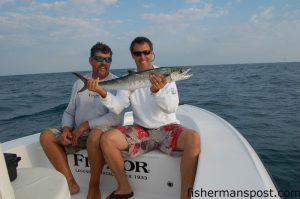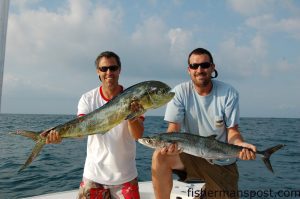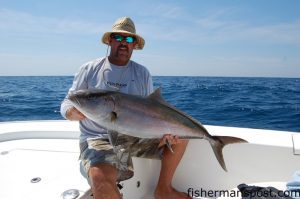You’re A Good Man Charlie Brown

Capt. Charles Brown of Old Core Sound Guide Service looks on as Gary Hurley holds a school king mackerel he hooked at a wreck just off Cape Lookout on a live pogy.
“These wrecks out east here are loaded up with kingfish and dolphin,” Capt. Charles Brown explained, his Core Sound accent (which for me at least is inimitable—it must be experienced firsthand) taking over as he idled down the Suzuki 250 powering his 23’ Venture bay boat. “Fishing out here gets you away from all the ditdots. They’re scared to cross the shoals.”
The proprietor of Old Core Sound Guide Service had pinned the throttle just moments before, guiding us through a slough between Shark Island (the best swimming beach on all the Crystal Coast, according to Charlie) and the point of Cape Lookout, and the lighthouse shining over the Cape’s shoals was still prominent on the horizon while the lifelong local fisherman talked me through setting out his live bait spread.
“They like naked baits on the downriggers—always have,” he continued, clipping an 8 lb. lead ball trailing a release clip onto the 200 lb. monofilament he prefers for his downrigger cables. “Wire sings; it’s no good. I get more bang for my buck with the down low baits. We’ll go about 25’ deep.”
Following his lead, I impaled one of the pogies darkening Charlie’s livewell onto the 1/2 oz. jighead most anglers associate with a dead bait rig, then clipped it to the release clip and sent it into the depths.
“Where’s my buoy, Gary?” the captain asked after sending his bait down. “Point me at it.” The Fisherman’s Post’s publisher complied, easing the boat into a gentle turn that brought us back on course for the buoy marking our first stop.
Our surface baits were on identical rigs as the downriggers except each wore a Blue Water Candy Featherweight skirt atop the jighead to add a little bit of fish-attracting flash in the early morning sunlight.
“I always run a head, and I like a little bit heavier head than most guys,” Charlie explained after the baits were set and swimming. “A 1/2 oz. head lets you pull a little bit faster, and you don’t have to deal with any of that helicoptering bull mess.”
Charlie had barely completed his first lazy lap around the buoy when the downrigger rod on my side popped free from its clip and the Fin-Nor levelwind’s clicker began singing a familiar tune as the 15 lb. line melted away.
I grabbed the rod from the downrigger holder and held on for the remainder of the run as Charlie cranked up the downrigger ball and the top line on my side of the boat.
“We’ll leave these other ones out unless we need to wind them up,” he said, turning the wheel slightly when he got back to the helm. “We’ll go into a little circle and keep him off that side of the boat.”
The fish’s first run had subsided. It was now swimming hard back at me, and I wound furiously trying in vain to keep a tight line. This was textbook king mackerel behavior, and my suspicions were confirmed moments later when the fish streaked by the port transom, still a little green for the gaff.
The second time I got a good look at my adversary, it had lapsed into the typical king death spiral. And as the fish’s circle grew tighter, Charlie appeared at my side with a gaff.
A few more ever smaller laps were all this king had in it, and the captain was soon holding our first fish on the gaff point. It wasn’t a monster, but a solid school king mackerel, and I was beginning to believe that Charlie’s assertion that the wreck we were fishing was loaded was no “bull mess.”
After a few quick shots of the fish while some of the sun’s first rays illuminated the black and white diamonds climbing Lookout light, we got the full spread back out and Charlie spun the boat back on the GPS track where we’d hooked up.
Most who know me know that I’m not exactly a morning person unless it comes to fishing (I’d rather be late for breakfast), but the 2:20 a.m. alarm I’d set this morning had definitely come early. However, after a highly successful trip last fall where Gary Hurley and I had been entertained both by Charlie and many hungry citation red drum, I’d fairly leaped out of bed. I rendezvoused with the boss at our office, and we made the drive from Wilmington to the Harkers Island Bridge boat ramp where the pre-dawn traffic was predictably light.
Blasting an 80’s hit from his truck’s stereo and prepping the Venture when we showed up, Charlie welcomed us warmly and we hopped aboard.

Gary Hurley and Max Gaspeny with the results of a double hookup at an artificial reef just off the Lookout Shoals. The dolphin and king fell for live pogies moments after the baits had hit the water.
“You’re going fishing with the man in the straw hat today, boys,” he said, seemingly producing a large-brimmed lid out of thin air and hanging it from his neck. “I’ve got to have a straw hat. One of my buddies says I’m the only fishing guide in North Carolina who could pull this off.” Though I’m not typically a hat-wearer, I’ve got to admit I was a little jealous of the sombrero, although I probably fall in the can’t-pull-it off category with the lion’s share of the state’s fishing guides.
Schools of pogies dimpled the surface in just about every direction as we rounded the channel bend on the west side of the island, and Charlie eased us towards one before slowing the motor to prepare a cast net that appeared as mysteriously as the hat.
One throw loaded the livewell, but Charlie was unsatisfied.
“I want that thing full, buddy,” he said, loading up the net again as we eased towards another school. Another toss had the well blacked out to the captain’s satisfaction, and stowing the cast net in the boat’s bow storage compartment, he revved the motor and followed the channel bends beside Harkers, past the light, and out Barden’s Inlet before slowing down at the shoals to take a quick glance around for rolling tarpon.
The tarpon weren’t there this morning, and Charlie took us southeast to our first stop.
The artificial reef lay in around 60’ of water, and we had it to ourselves as we set out those first lines.
After our first hookup, it didn’t take long to find the action again, and Gary soon landed a king a bit bigger than mine at around 10 lbs.
The bite had come nearly exactly where we’d hooked up the first fish, and after Gary battled his mackerel to the boat, we reset the spread as Charlie again pointed the bow back towards the action.
Our next pass over the bite zone, an area just north of the buoy with no particular structure or bait showing up on the depth finder but obviously with plenty of fish, failed to disappoint.
Just before we got there, Charlie had a sneaking suspicion about why our top lines hadn’t been hit, and he had us bring them in.
“Let’s take a look at those baits, boys. I’ve got a feeling something’s up,” he said as we cranked in the surface rods, 20 lb. Fin Nor spinning setups.
Sure enough, each bait had been slashed and killed by a king that failed to find the stinger treble trailing Charlie’s jigheads. We re-baited and sent the baits back out. Immediately, another short strike popped the downrigger on my side but failed to find the hooks, and I sent back a fresh pogy.
Just as I let the clutch back on the downrigger to drop the bait, the line popped out of the release clip. I thought I’d put it in the clip poorly, but as I picked up the rod to grab the line and reattach it, the drag began singing yet again.
This was a bit larger fish than my first, and I enjoyed the king mackerel’s first run as Charlie looked on grinning.
“This is what it’s all about, boys,” he said, and at nearly the moment the words left his lips, our starboard top line bent over and the drag began singing along. Gary quickly picked up the spinner, and I looked over in time to see a beautiful cow dolphin rocket out of the sea three consecutive times.
“There you go boys. I told you it was loaded,” Charlie said, cranking up the remaining downrigger ball. Apparently a double hookup merited clearing the entire spread, and the captain took care of the fishless lines while Gary and I followed our fish around the boat.
After a few ducking and reaching exercises to keep our lines from crossing, my king opened its textbook and charged the boat.
Reeling furiously once again, I caught up to it, and in a repeat of my first fish’s performance, it tore past the boat, made another short run, and then came up circling, all while the captain waited for his shot with gaff in hand.
The moment it circled within reach, the steel found the fish’s flank, and Charlie swung a mirror image of Gary’s king into the boat.
The dolphin wasn’t ready to meet Charlie’s gaff just yet, and it regaled us with the typical stubborn dolphin battle, settling down from its initial jumps into a broadside turn to us, using its flat shape as a kind of planer and making it difficult for the boss to make much progress. Occasionally it would turn and dart towards the boat, then surge back away, melting a few more yards of 15 lb. test of the reel than it had allowed Gary to get back.
Progressively, the fish grew a bit more docile, and the battle began to turn in Gary’s direction. A few more little surges were all the dolphin could muster in the fight’s final minutes, and eventually the broadside planing trick was the only one left in its arsenal.

Capt. Charles Brown (or the Man in the Straw Hat), of Old Core Sound Guide Service, with a 40 lb. amberjack that fell for a live pogy around a wreck in 60' off the beach at Cape Lookout.
Gary finally put the fish within Charlie’s gaff range, and the captain planted the big hook and hauled the lit-up fish over the gunwale.
With a double header producing another king and a 15 lb. dolphin less than an hour after our fishing day began, we were excited to say the least to get the baits back in the water and find out what wanted to bite next.
The wrecks east of Lookout see traffic not only from king mackerel and dolphin, but cobia, sailfish, wahoo, and other blue water predators as well, so anglers never know what to expect next when live-baiting the area. Each year, anglers fishing king mackerel tournaments land wahoo approaching and exceeding triple digits on live bait gear here, and though it’s more of a fall bite, the Lookout wrecks are close enough to the Gulf Stream that just about anything could show up at any time.
Our next four bites all proved to be kings (including a big smoker that likely weighed 30 lbs. and pulled the hooks after giving us too good a look at its size), with the ones we landed near cookie-cutter copies in the 10-12 lb. range.
After we put more kings on ice, Charlie wanted to check out a spot that he’s seen and caught big numbers of sailfish at in the past. And who were we to object? We were on the man in the straw hat’s turf and playing by his rules.
Charlie ran us offshore a few miles to the spot, a hump on the bottom that rises into the high 40’ range from the 60-70’ deep water around it, and we trolled the area for the better part of an hour, unfortunately without a billfish encounter.
Not one to take a lack of action for long, Charlie had soon punched coordinates for another one of his Lookout wrecks into the GPS, and we stowed the tackle for a quick run north.
As soon as we got within visual range of the wreck, though, the captain clearly didn’t like what he saw.
“The darn dive boat’s out here,” he said pointing to a large boat that had passed us earlier lying a mile off the bow. “We’ll let them be I guess.”
He soon had another wreck’s numbers up on the screen, and we ran north and a little tighter to the beach. This wreck, too, had a dive boat on it, but apparently the area was a little larger. We laid out pogies and began trolling, giving the divers a wide berth. It took even less time to find action here than it had at our first stop, and I picked up a screaming reel just moments after the spread was complete.
The cow dolphin seemed determined to give us a show, and this one gave a few more jumps than Gary’s ‘phin had. I don’t think it will matter how many times it happens, there’s very little I like more than holding a fishing rod with a cartwheeling sea creature on the other end.
Holding the rod doesn’t get the fish to the boat, however, and I soon settled into a remarkably similar battle to Gary’s with the dolphin. I’d gain a bit of line when the fish made a little jumping tear that carried it towards the boat, then it would rip a few more yards off when its aerial acrobatics carried it in the other direction. When line wasn’t coming or going, fighting the teenage fish on 15 lb. would turn into a stalemate as she pulled the flanking planer fish trick.
“I just can’t believe how some people fish for these fish,” Charlie said chuckling at my vain attempts to make headway on the mahi. “Trolling for them with 50 Wides? Isn’t this just a little bit more fun?”
It’s surely more fun to fight the fish with the light gear than to skip it to the boat on a locked-down lever drag, and the captain seemed to be having as much fun watching me as I was.
The dolphin finally tired, and interrupted by frequent short runs of protest, I began putting steady line on the reel. I finally worked the fish within Charlie’s reach, and our second dolphin of the day hit the ice.
Our next baits out were hammered after less than five minutes in the water, and these fish were definitely brutes. After a back and forth struggle with no sight of the fish for 20 minutes, the three of us came to the correct conclusion that we were fighting amberjacks. My fish finally surfaced after just under 30 minutes, but Gary’s was a little larger and a lot more feisty. It kept him occupied for the next quarter-hour, finally coming within reach for a quick photo session.
My fish had been around 30 lbs., with Gary’s closer to 40, and the fish worked us over hard on the light tackle. Though fighting amberjacks on the light gear is fun, one’s plenty for me (for Gary, too, I’m almost sure), and the pair were certainly enough for Charlie.
“AJ’s are fired up,” he said, considering where to go next. “Did you see the ones following the ones you had? I’m afraid that’s all we’re going to catch here, boys. We’re hitting the road.”
Settling on returning to the artificial reef where we’d found good action at the beginning of the day, Charlie pointed us south, and we ran back towards the wreck just off the whitewater of Lookout Shoals. When we got back, two other boats were fishing and hooked up, and it didn’t take us long to become the third. The kings were still voracious, and we finished off our 9-fish limit in under an hour, adding a large spanish mackerel that fell for one of our pogies, too.
The breeze started freshening about the same time our last king hit the deck, and Charlie soon decided it was time to hit the road again, this time for the boat ramp. Gary and I couldn’t have been more pleased, as we’d had virtually nonstop action all day, and after getting up before 3:00 a.m., making it back to Wilmington before sunset was extremely appealing.
Capt. Charles Brown has been fishing the area from Beaufort to Ocracoke Inlets in the ocean and backwaters his entire life, and chases speckled trout, puppy drum, citation class “old” drum, tarpon, and a host of other species when he’s not live-baiting the wrecks off Lookout. A trip with him is not only almost certain to be action-packed on the fishing side, he’s truly one of the most entertaining people I’ve had the pleasure of meeting, and I’m not sure written words can express his personality. It’s just something that has to be experienced firsthand.
Interested anglers can contact him to talk about a trip at (252) 728-2422 or visit www.oldcoresound.com for more information.
